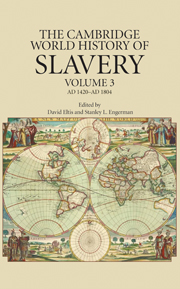Book contents
- Frontmatter
- Contents
- List of Maps, Figures, and Tables
- Contributors
- Series Editors' Introduction
- 1 Dependence, Servility, and Coerced Labor in Time and Space
- PART I SLAVERY IN AFRICA AND ASIA MINOR
- PART II SLAVERY IN ASIA
- PART III SLAVERY AMONG THE INDIGENOUS AMERICANS
- PART IV SLAVERY AND SERFDOM IN EASTERN EUROPE
- PART V SLAVERY IN THE AMERICAS
- PART VI CULTURAL AND DEMOGRAPHIC PATTERNS IN THE AMERICAS
- PART VII LEGAL STRUCTURES, ECONOMICS, AND THE MOVEMENT OF COERCED PEOPLES IN THE ATLANTIC WORLD
- PART VIII SLAVERY AND RESISTANCE
- Index
Series Editors' Introduction
Published online by Cambridge University Press: 28 September 2011
- Frontmatter
- Contents
- List of Maps, Figures, and Tables
- Contributors
- Series Editors' Introduction
- 1 Dependence, Servility, and Coerced Labor in Time and Space
- PART I SLAVERY IN AFRICA AND ASIA MINOR
- PART II SLAVERY IN ASIA
- PART III SLAVERY AMONG THE INDIGENOUS AMERICANS
- PART IV SLAVERY AND SERFDOM IN EASTERN EUROPE
- PART V SLAVERY IN THE AMERICAS
- PART VI CULTURAL AND DEMOGRAPHIC PATTERNS IN THE AMERICAS
- PART VII LEGAL STRUCTURES, ECONOMICS, AND THE MOVEMENT OF COERCED PEOPLES IN THE ATLANTIC WORLD
- PART VIII SLAVERY AND RESISTANCE
- Index
Summary
This is the third volume of The Cambridge World History of Slavery, exploring the various manifestations of coerced labor in Africa, Asia, and the Americas between the opening up of the Atlantic world and the formal creation of the new nation of Haiti. Slavery has been among the most ubiquitous of all human institutions, across time and place, from earliest history until, some would argue, the present day. Yet its durability and ubiquity are not widely recognised and, where they are, they seem poorly understood by the general public and scholars alike. A central aim of these volumes, which cover many different times and places, is to help to place the existence and nature of slavery against the backdrop of the broader human social condition.
Slavery has appeared in many different forms and is not always easy to separate from other forms of coerced labor. Nevertheless, there are basic similarities that emerge from the contributions that follow. Most critical of these is the ownership of one human by another, and the ability to buy and sell the human chattel such ownership creates.
- Type
- Chapter
- Information
- The Cambridge World History of Slavery , pp. xiii - xivPublisher: Cambridge University PressPrint publication year: 2011

